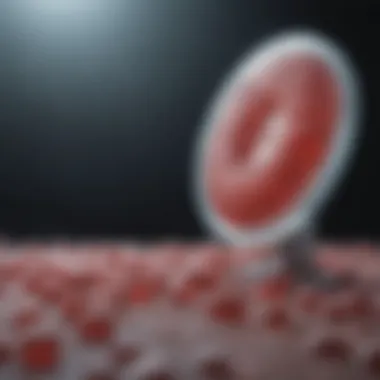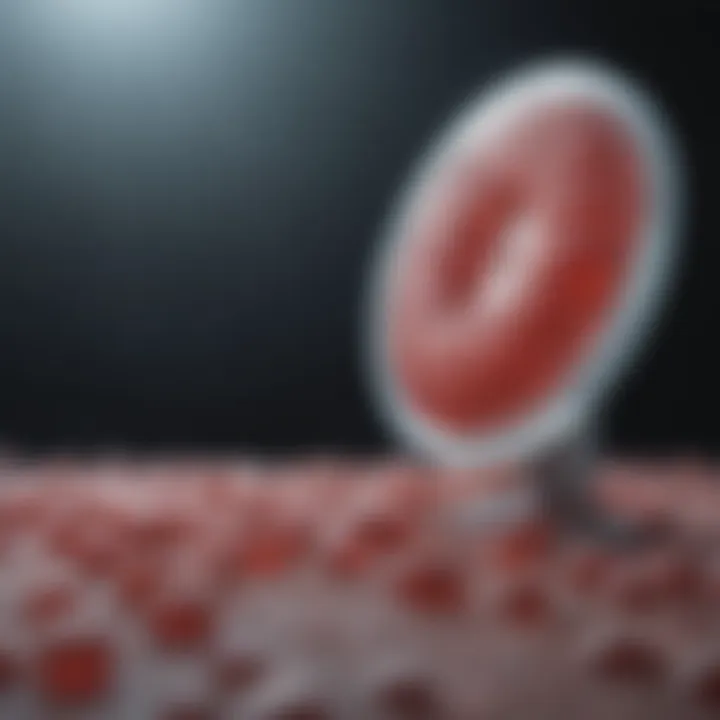Bacterial STDs: Treatment Options and Antibiotic Efficacy


Intro
Bacterial sexually transmitted diseases (STDs) remain a pressing public health concern across the globe. These infections not only lead to significant health issues but also carry social stigmas that often complicate treatment and prevention efforts. Understanding the types of bacterial STDs, their symptoms, and the effective treatment options available is essential for educators, healthcare professionals, and researchers alike. Antibiotics play a crucial role in treating these infections, yet the emergence of antibiotic resistance is a growing threat that warrants immediate attention.
In this article, we will analyze various types of bacterial STDs. These include Chlamydia, Gonorrhea, and Syphilis, each presenting unique challenges in diagnosis and treatment. Moreover, we will explore how antibiotics work against these infections, mechanisms of resistance that can emerge, and ongoing research that aims to enhance treatment efficacy and public health initiatives. Prevention strategies also play a significant role in managing the spread of bacterial STDs.
Our exploration will be comprehensive, integrating scientific findings and practical insights, thereby offering a rounded perspective that is essential for informed discourse in academia and public health.
Research Overview
Summary of Key Findings
The key findings of various studies indicate that bacterial STDs are prevalent in diverse populations and can often go unnoticed due to the asymptomatic nature of some infections. Chlamydia is one of the most common bacterial STDs, often impacting younger adults. Gonorrhea has also seen a resurgence in certain demographics, highlighting a need for ongoing surveillance and treatment innovations. Syphilis is experiencing a revival, especially among men who have sex with men, suggesting significant shifts in sexual health patterns.
Importance of the Research in Its Respective Field
Research on bacterial STDs is critical for informing treatment and prevention strategies. As antibiotic resistance poses an increasing threat, understanding how these infections evolve is essential for developing effective interventions. Continued investigation into the epidemiology of bacterial STDs aids public health officials in allocating resources effectively, refining educational efforts, and addressing social stigmas that hinder access to care.
Methodology
Description of the Experimental or Analytical Methods Used
Research methods typically include quantitative analyses of incidence and prevalence rates of bacterial STDs. Studies often utilize cross-sectional surveys and cohort studies to gather data on risk behaviors, treatment outcomes, and antibiotic resistance patterns.
Sampling Criteria and Data Collection Techniques
Sampling may involve diverse population groups to ensure representativeness. Researchers often conduct interviews, distribute surveys, and analyze clinical data to collect essential information on patient demographics, symptomatology, and treatment regimens. Information on resistance is gathered through laboratory testing, which identifies the effectiveness of various antibiotics against specific bacterial strains.
"Antibiotic resistance among sexually transmitted bacteria is a growing concern, necessitating urgent research and public health interventions."
As we continue through the article, we will delve deeper into each bacterial STD, examining symptoms, diagnostic methods, and the role antibiotics play in treatment, as well as the challenges posed by resistance and future management strategies.
Prelims to Bacterial STDs
Bacterial sexually transmitted diseases (STDs) are significant health issues affecting individuals worldwide. They represent complex challenges for public health systems, not only due to their direct impact on health but also because of their broader social implications. Understanding bacterial STDs is essential for education, prevention, and effective treatment. This section will outline the definitions and importance of studying bacterial STDs, alongside their prevalence statistics.
Definition and Importance
Bacterial STDs are infections primarily transmitted through sexual contact caused by bacteria. Common bacterial STDs include chlamydia, gonorrhea, and syphilis. These infections can lead to severe health complications if left untreated. For instance, untreated chlamydia can cause infertility in both men and women. Moreover, the importance of addressing bacterial STDs extends beyond physical health.
Preventative education and open discussions about STDs can reduce stigma and promote healthier sexual practices. This education is equally important in informing the public about the necessity for routine testing and treatment options available.
Prevalence Statistics
Prevalence statistics underline the urgency of addressing bacterial STDs in contemporary society. According to the World Health Organization (WHO), millions of new cases of STDs occur each year, with bacterial STDs making up a substantial portion. In the United States, the Centers for Disease Control and Prevention reported around 1.8 million chlamydia cases in a year, marking it as the most reported bacterial STD.
Gonorrhea and syphilis also show increasing rates, raising concerns among health policymakers. The rise in antibiotic-resistant strains adds another layer of complexity in managing these diseases. Monitoring and understanding these statistics is crucial for tailoring public health strategies and improving health outcomes for affected populations.
Understanding bacterial STDs is not only about treatment but also about prevention, education, and enhancing overall public health.
Common Types of Bacterial STDs
Understanding the common types of bacterial STDs is vital for both education and public health. These infections can lead to severe health complications if left untreated. Awareness of different bacterial STDs helps individuals recognize symptoms early, seek appropriate testing, and receive effective treatment. This section will highlight three significant types of bacterial STDs: Chlamydia, Gonorrhea, and Syphilis. By understanding the specific characteristics and consequences of each, one can make informed decisions regarding their sexual health and risk mitigation.
Chlamydia
Chlamydia is one of the most prevalent bacterial STDs, particularly among young adults. This infection is caused by the bacterium Chlamydia trachomatis. Many cases are asymptomatic, meaning individuals can carry the infection without showing symptoms. However, if symptoms do occur, they may include abnormal discharge, burning during urination, and pelvic pain.


Prompt diagnosis is crucial.
Treating Chlamydia is straightforward with antibiotics such as Azithromycin or Doxycycline. Effectiveness is high, with proper treatment leading to a complete cure in most instances. Regular screenings are important, especially for sexually active individuals under 25, to prevent complications like infertility or pelvic inflammatory disease.
Gonorrhea
Gonorrhea is another widespread bacterial STD resulting from infection with Neisseria gonorrhoeae. Like Chlamydia, Gonorrhea often presents without clear symptoms. When symptoms do appear, they may include painful urination, discharge from the genitals, and in women, potential vaginal bleeding between periods.
Gonorrhea is typically treated with dual therapy, often involving Ceftriaxone and Azithromycin. As with Chlamydia, timely treatment is essential to avoid long-term health issues. Recent studies indicate a rising trend in antibiotic resistance, making vigilance and updated treatment protocols crucial for effective management.
Syphilis
Syphilis, while less common than Chlamydia and Gonorrhea, poses serious risks if not treated. It is caused by the bacterium Treponema pallidum. The infection progresses through stages: primary, secondary, latent, and tertiary. Each stage has distinct symptoms, ranging from painless sores to rashes and potentially, heart and neurological complications in the later stages.
The treatment for Syphilis is usually Benzathine penicillin G, which remains highly efficacious. Early detection, often through blood tests and physical examinations, is key to controlling the spread and avoiding severe health complications. Regular testing and awareness can significantly reduce the incidence of Syphilis.
Symptoms of Bacterial STDs
Understanding the symptoms of bacterial STDs is essential in promoting awareness and timely intervention. Symptoms often signal the presence of an infection and can vary significantly among individuals. A clear presentation of symptoms can lead to earlier diagnosis and treatment, helping to reduce the risk of complications. Awareness enables individuals to seek medical help sooner rather than later.
General Symptoms
Bacterial STDs share common symptoms that may not be immediately recognizable as indicative of an STD. Individuals may experience:
- Unusual discharge from the genitals. This can be yellow, green, or white in appearance.
- Pain during urination or sexual intercourse.
- Abdominal pain or discomfort, which can signal a more serious infection.
- Swelling in the genital area or unusually itchy skin.
- Fever or swollen lymph nodes, indicating a possible systemic infection.
These symptoms can overlap with other health issues, making self-diagnosis challenging and often leading to delays in treatment. Consistent monitoring for these signs is vital for anyone at risk of STDs.
Gender-Specific Symptoms
Symptoms can differ based on gender, reflecting biological and anatomical variations. For example:
- In Women: Women may experience increased vaginal discharge, bleeding between periods, or pain during periods. These symptoms can be mistaken for other gynecological issues, which makes diagnosis more difficult.
- In Men: Men may notice painful or swollen testicles and a persistent sore throat if the infection is oral. These symptoms can be dismissed as less serious, leading to potential complications.
It is important for both genders to recognize these symptoms for what they are. If experienced, medical consultation can help determine the presence of an STD and allow for appropriate treatment.
"Awareness of symptoms can lead to early detection and more effective treatment, reducing the long-term impact of bacterial STDs."
In summary, the understanding of symptoms related to bacterial STDs is a crucial element in managing sexual health. Early identification and treatment can significantly improve outcomes for affected individuals.
Diagnosis of Bacterial STDs
Understanding the diagnosis of bacterial sexually transmitted diseases (STDs) is crucial for effective management and treatment. Early and accurate diagnosis can not only mitigate the severe health consequences but also reduce the risk of transmission to others. This section will explore different diagnostic methods, their importance, and the considerations involved.
Laboratory Testing Methods
Laboratory testing is the cornerstone of diagnosing bacterial STDs. Several methods are available, each tailored to detect specific pathogens.
- Nucleic Acid Amplification Tests (NAATs): These tests are currently the most sensitive and specific for bacterial STDs. NAATs can effectively identify the genetic material of bacteria such as Chlamydia trachomatis and Neisseria gonorrhoeae. They usually involve taking samples from urine or genital secretions.
- Culture Tests: Although less common now due to the rapid advancement of NAATs, culture tests still play a role. Samples are taken from the affected area and placed in a medium conducive to bacterial growth. This method helps identify the pathogen and determine its antibiotic sensitivity profile.
- Serology Tests: Blood tests can be used to detect antibodies against certain bacterial STDs, like Syphilis. While they can confirm exposure, they do not indicate an active infection.
- Microscopic Examination: Sometimes, direct visualization of the sample under a microscope can provide immediate insights. This method can help identify organisms rapidly, though it is less precise compared to other tests.
Each method has its benefits and limitations. Factors such as the type of infection, stage of the disease, and patient history must influence the choice of testing.
Symptom-Based Diagnostics
Symptom-based diagnostics play a vital role in identifying bacterial STDs, especially in settings where laboratory facilities might be limited. Clinical evaluation begins with a comprehensive medical history followed by a physical examination.
- Patient Symptoms: Many bacterial STDs present with symptoms such as abnormal discharge, itching, or painful urination. In some cases, patients may be asymptomatic, which complicates diagnosis. Therefore, understanding each organism's typical signs becomes crucial. For example, women may exhibit more subtle symptoms, leading to delayed diagnosis of conditions like Chlamydia.
- Physical Examination: Healthcare providers often conduct a thorough examination of the genital area to look for visible signs of STDs. Ulcers, rashes, or swelling can provide critical clues about the underlying infection.
- Risk Assessment: Assessing risk factors such as recent sexual partners, history of STDs, or engagement in high-risk behaviors can guide the diagnostic process. This information helps prioritize which tests should be administered to the patient.
In summary, while laboratory tests offer precise diagnosis, symptoms provide valuable insights that can guide preliminary assessments. Combining both approaches often yields the best outcomes for effective treatment.


Role of Antibiotics in Treatment
Antibiotics are central to the management of bacterial sexually transmitted diseases (STDs). Understanding their role is crucial for healthcare professionals and patients alike. The effectiveness of antibiotics against specific bacteria, coupled with their wide accessibility, makes them a primary treatment choice. However, this benefit also comes with many considerations, such as antibiotic resistance. A comprehensive grasp of how antibiotics work and the types available for bacterial STDs informs both patient care and public health strategies.
How Antibiotics Work
Antibiotics function primarily by targeting bacterial cells, exploiting differences between bacterial and human cells. They can be classified into two categories: bactericidal and bacteriostatic.
- Bactericidal antibiotics kill bacteria outright. They interfere with critical processes such as cell wall synthesis. Penicillin is a notable example; it disrupts the synthesis of the bacterial cell wall, leading to cell lysis and death.
- Bacteriostatic antibiotics, in contrast, inhibit bacterial growth and reproduction. They do this by disrupting protein synthesis. Tetracycline is an example of this class, effectively interfering with the ability of bacteria to produce essential proteins.
The choice of antibiotic depends on the specific bacteria causing the STD and the severity of the infection. Health providers also consider the patient’s medical history and any potential allergies to antibiotics.
Types of Antibiotics Used
Several classes of antibiotics are typically used in the treatment of bacterial STDs. Each antibiotic has its specific spectrum of activity and indications. Some common antibiotics include:
- Azithromycin: Often used for Chlamydia and Gonorrhea. It is preferred for its single dose regimen, promoting patient compliance.
- Doxycycline: Another effective option against Chlamydia, it is usually administered over a course of seven days.
- Ceftriaxone: This antibiotic is vital when treating Gonorrhea, especially in cases of possible co-infection with Chlamydia.
- Penicillin: The go-to choice for treating Syphilis, particularly in pregnant women, due to its safety profile.
The selection of antibiotics must also account for regional resistance patterns. Ongoing research is essential to adapt and improve treatment protocols as resistance continues to evolve.
"Antibiotics remain a powerful weapon against bacterial STDs, but their efficacy can be compromised by resistance. Constant vigilance is needed to maintain their effectiveness."
Public health strategies promoting education on appropriate antibiotic use can mitigate resistance. Providing guidelines for testing and treatment ensures that antibiotics are used judiciously, enhancing their efficacy for future generations.
Antibiotic Resistance in STDs
Antibiotic resistance is a paramount issue in the treatment of bacterial sexually transmitted diseases. This chapter examines its significance, including how resistance alters treatment strategies and outcomes. Understanding antibiotic resistance is crucial for healthcare professionals, researchers, and patients alike. The rise of resistant bacterial strains directly affects the efficacy of treatments, demanding innovative approaches and concerted global efforts.
Understanding Resistance Mechanisms
Resistance mechanisms are varied and complex. Bacteria can resist antibiotics through several strategies:
- Enzymatic destruction: Some bacteria produce enzymes that break down antibiotics. This prevents the drug from being effective.
- Altered target sites: Bacteria may change the structure of their cellular targets, rendering the antibiotic ineffective.
- Efflux pumps: Certain bacteria can expel antibiotics from their cells before the drugs can take effect.
- Increased permeability: Some bacterial membranes become less permeable to antibiotics, restricting drug entry.
Each of these mechanisms contributes to the survival of bacteria despite antibiotic treatment. Understanding how these mechanisms operate allows for better treatment protocols and the development of new strategies to combat resistant strains.
Impact on Treatment Options
Antibiotic resistance significantly alters treatment options for bacterial STDs. When standard treatments fail, physicians find themselves facing several challenges, including:
- Limited choices: As resistance spreads, available effective antibiotics diminish. Providers may need to resort to less optimal treatments that may have more side effects.
- Increased healthcare costs: Treating resistant infections often requires longer hospital stays, more expensive therapies, or the use of combination therapy—a strategy where multiple drugs are used to fight the infection.
- Impact on public health: The rise in resistance can lead to increased transmission rates of STDs, complicating public health efforts aimed at controlling and reducing these diseases.
To address these challenges, ongoing research is necessary. The goal is to develop new antibiotics and treatment regimens while also emphasizing prevention methods. Education, along with responsible antibiotic usage, is essential in managing the implications of antibiotic resistance in STDs.
"Antibiotic resistance is an urgent public health challenge that requires collaborative efforts across various sectors to mitigate its impact on STD treatment."
By understanding mechanisms and impacts, it becomes clearer why combating antibiotic resistance is critical in effectively managing bacterial STDs and protecting public health.
Prevention of Bacterial STDs
Preventing bacterial sexually transmitted diseases (STDs) is a crucial aspect of public health and individual well-being. The importance of prevention cannot be overstated, as it reduces rates of infections and mitigates complications associated with untreated STDs. With effective prevention strategies, individuals can empower themselves to engage in sexual activity safely, while also contributing to the wider community's health.
Preventative measures can decrease the incidence of STDs, which are often difficult to diagnose and can lead to serious health issues if left untreated. Beyond individual health, proactive prevention helps lessen healthcare costs associated with treatment of these infections, ultimately alleviating the burden on healthcare systems.
Safe Practices
Implementing safe practices is essential to the prevention of bacterial STDs. The following strategies should be considered:
- Consistent use of condoms: Condoms are highly effective barriers that help reduce the transmission of STDs. Proper use during every sexual encounter is essential, regardless of the perceived risk level.
- Regular testing: Regular testing for STDs can identify infections early, even in asymptomatic individuals. Routine screenings can help ensure that any infections are treated promptly, preventing further transmission.
- Mutual monogamy: Having a single sexual partner who is also tested and free from STDs greatly reduces the risk of infection. Open communication about sexual history and health is vital in establishing trust and safety.
- Abstinence: The most effective way to prevent STDs is through abstinence. While this may not be a feasible lifestyle choice for everyone, it is the only method that guarantees 100% protection against STDs.


By adhering to these safe practices, individuals can significantly lower their risk of acquiring or transmitting bacterial STDs.
Education and Awareness
Education and awareness serve as powerful tools in the prevention of bacterial STDs. They empower individuals with the knowledge necessary to make informed decisions about their sexual health. Important components include:
- Access to information: Providing comprehensive education on STDs in schools, community centers, and healthcare facilities can help individuals understand transmission routes, symptoms, and treatments. This information can encourage proactive attitudes toward sexual health.
- Awareness campaigns: Public health initiatives that raise awareness about STDs can change societal attitudes and reduce the stigma associated with these infections. Together, organizations and communities can focus on promoting safe practices and encouraging regular testing.
- Engaging healthcare providers: Encouraging healthcare professionals to engage in open discussions about sexual health with patients can help destigmatize the topic and normalize conversations about prevention strategies.
Education and awareness lead to a culture of prevention that fosters healthier communities.
Through concerted efforts in education, awareness, and safe practices, the transmission of bacterial STDs can be significantly reduced. These measures contribute to individual well-being and societal health, highlighting the importance of proactive public health strategies.
Ongoing Research in STD Management
Ongoing research in the management of bacterial sexually transmitted diseases (STDs) is vital for the development of effective treatment and prevention strategies. The ever-evolving landscape of bacterial resistance necessitates continuous scientific inquiry. This section will discuss innovative treatment approaches and the potential for vaccines, both of which promise to enhance our response to STDs.
Innovative Treatment Approaches
Researchers are exploring several innovative treatment approaches to combat bacterial STDs more efficiently. One notable direction is the use of combination therapies. These involve administering two or more antibiotics simultaneously. The rationale is to enhance treatment efficacy and minimize the chances of resistance developing. This strategy has received attention especially in the treatment of gonorrhea, where resistance rates have outpaced single-drug treatment success.
Another area of focus is the role of bacteriophage therapy. This method utilizes viruses that specifically infect bacteria, thus targeting and destroying bacterial strains without harming human cells. Preliminary studies show promising outcomes in laboratory settings. However, translating this research into clinical application requires more extensive trials to address safety and effectiveness in humans.
Furthermore, researchers are investigating the potential of using immunomodulators. These compounds may enhance the body’s immune response to bacterial infections, potentially reducing the need for antibiotics. The combination of these innovative approaches could shift the treatment landscape significantly.
Potential Vaccines
The development of vaccines against bacterial STDs represents a significant potential advancement in public health. Current vaccines, such as those for syphilis, are still in experimental stages. However, the urgency for effective vaccines cannot be overstated. A successful vaccine could provide a preventative measure for high-risk populations and reduce the overall incidence of STDs.
Several research teams are working on different types of vaccine formulations. For instance, one approach involves using inactivated or attenuated bacteria. This stimulates an immune response without causing disease. Another promising avenue includes the use of recombinant proteins that mirror the surface antigens of bacteria. Such strategies aim to promote an immune memory that can prevent future infections.
As research progresses, the hope is that effective vaccines will not only prevent infections but also reduce the stigma associated with STDs, leading to better health outcomes overall.
Social Implications of Bacterial STDs
The social implications of bacterial sexually transmitted diseases (STDs) extend far beyond individual health consequences; they touch on cultural perceptions, healthcare accessibility, and public policy. Understanding these implications allows us to not only confront the medical aspects of STDs but also address the societal barriers and stigma that accompany these infections. The interplay between STDs and society illustrates the need for comprehensive strategies that encompass treatment, prevention, and education.
Stigmatization and Public Perception
Stigmatization plays a significant role in how bacterial STDs are viewed within society. Many individuals with STDs often face negative judgments and discrimination, which can prevent them from seeking necessary medical care. This stigma is fueled by misconceptions about the causes and behaviors associated with STDs.
- Public Awareness: Often, educational campaigns focused on STDs are insufficient, leading to a gap in knowledge. Incorrect assumptions may perpetuate stigma, making individuals hesitant to discuss their concerns.
- Social Consequences: Individuals diagnosed with STDs may experience embarrassment, shame, or isolation, which can result in mental health stressors. This stigma is not only detrimental for the individuals but also complicates public health efforts.
- Changing Perceptions: Research studies indicate that increasing awareness and education can reduce stigma. Promoting understanding of STDs as common health issues can improve community perceptions.
"The negative perceptions readily attached to STDs can hinder effective public health interventions. Educated populations are more likely to engage in proactive healthcare choices."
Healthcare Access and Equity
Access to healthcare services is critical in managing bacterial STDs effectively. Disparities in access often reflect deeper systemic issues within healthcare systems. Inequities in healthcare can lead to undiagnosed infections and untreated conditions, posing risks not only to individuals but also to public health at large.
- Barriers to Treatment: Factors such as cost, lack of insurance, and geographic limitations create barriers for certain populations. Low-income communities or rural areas often struggle with limited healthcare services.
- Cultural Sensitivity: Misunderstanding or lack of knowledge about different cultural contexts can define how treatment is provided. Health systems need to consider cultural competence when addressing the needs of diverse populations
- Policy Measures: Public health initiatives should focus on policies that enhance access, promote equity, and safeguard the health of at-risk populations. Funding for educational programs and community health services can bridge some gaps in access.
Finale
The conclusion serves as a vital aspect of this article on bacterial STDs. It encapsulates the key findings while emphasizing the necessity of understanding these health challenges faced by society. Comprehending the nature and implications of bacterial sexually transmitted diseases can lead to more effective treatment approaches and improved health outcomes.
Recap of Key Points
In this article, we have explored several crucial components:
- Definition and Importance: Recognized bacterial STDs as significant public health issues that require attention.
- Common Types: Discussed various bacterial STDs, such as Chlamydia, Gonorrhea, and Syphilis, detailing their implications on health.
- Symptoms and Diagnosis: Analyzed the symptoms, diagnostic tests, and how practitioners identify these infections effectively.
- Role and Types of Antibiotics: Highlighted how antibiotics play a central role in treatment and the various types employed against these diseases.
- Antibiotic Resistance: Investigated the challenges posed by antibiotic resistance and its impact on treatment efficacy.
- Prevention Methods: Reviewed preventive measures and the importance of education to curtail the spread of STDs.
- Research and Future Directions: Addressed ongoing research and potential vaccines that may enhance future treatment options.
- Social Implications: Considered societal perceptions, stigmatization, and healthcare access related to STDs.
Future Directions for Research and Treatment
Moving forward, research in bacterial STDs must tackle various pressing issues. Among these, understanding antibiotic resistance remains paramount. More effective strategies need to be developed to combat resistant strains, which hinder treatment outcomes. Additionally, there is a growing need for innovative treatment methodologies, including combinational therapies that can enhance efficacy.
Potential vaccine developments also represent a critical area of focus. New vaccines could provide preventive measures, ultimately reducing the incidence of bacterial STDs. Moreover, ongoing public health campaigns will be essential in raising awareness and enhancing knowledge about these diseases. Addressing the stigma surrounding bacterial STDs is crucial for promoting healthcare access and encouraging individuals to seek timely treatment.







